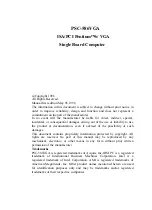
Chapter 2
Introduction
Kontron User's Guide PC/104-520
4
2.2
PC/104 an Embedded PC Standard
By standardizing hardware and software around the broadly supported PC architecture, embedded system
designers can substantially reduce development costs, risks, and time-to-market.
For these reasons, companies that embed microcomputers as controllers within their products seek ways to
reap the benefits of using the PC architecture. However, the standard form factor of a PC bus (12.4” x 4.8”)
and its associated card cages and backplanes are too bulky and expensive for most embedded control appli-
cations.
The only practical way to embed the PC architecture in space and power sensitive applications has been to
design a PC chip by chip directly into the product. But this runs counter to growing trend away from
“reinventing the wheel.” Whenever possible, management encourages outsourcing of components and
technologies to reduce development costs and accelerate product design cycles.
A need has arisen for a more compact implementation of the PC bus, satisfying the reduced space and power
constraints of embedded control applications. PC/104 was developed in response to this need. It offers full
architecture, hardware and software compatibility with the PC bus but in ultra-compact (3.6” x 3.8”)
stackable modules. PC/104 is ideally suited to the unique requirements of embedded control applications.
Although configuration and application possibilities with PC/104 modules are practically limitless, there are
two ways to use them in embedded system designs:
Standalone module stacks
PC/104 modules are self-stacking. The modules are used like ultra-compact bus boards
but do not need backplanes or card cages.
Component line applications
In this configuration, the modules function as highly integrated components, plugged
into custom carrier boards that contain application specific interfaces and logic.






























